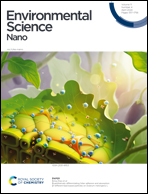Utilization of lead-based saturated adsorbents for the fabrication of battery-like hybrid asymmetric supercapacitors†
Abstract
Lead, one of the most poisonous heavy metals, must be eliminated from the environment. Adsorption is one of the most employed techniques that generates contaminated waste once the lifetime of the adsorbent has finished. This study deals with the above problem through the preparation of a S-doped graphitic CN/ZIF composite for efficient Pb adsorption, heat treatment of the composite after adsorption to anchor the adsorbed Pb, and fabrication of the heat-treated composite as supercapacitor anode. A maximum adsorption of 800 mg g−1 of Pb at 45 °C was obtained with 95% of adsorption completed within the first 40 min. Pb was permanently anchored by heat treatment of the adsorbent after adsorption, which led to the formation of different electroactive components. The different materials formed were identified through XRD, FESEM, HRTEM, Raman, and XPS analysis. This material was used as anode against a MnO2 cathode to fabricate a supercapacitor, showing an excellent specific capacitance of 364 F g−1 at 0.5 A g−1 with an energy density of 113 Wh kg−1 and power density of 750 W kg−1. The device could also maintain energy density of 13.3 Wh kg−1 at a high power density of 6000 W kg−1. The supercapacitor had an outstanding stability of 108% after 10 000 cycles at 10 A g−1. Two such device connected in series could also light up a green LED and operate a 2 V DC fan.



 Please wait while we load your content...
Please wait while we load your content...